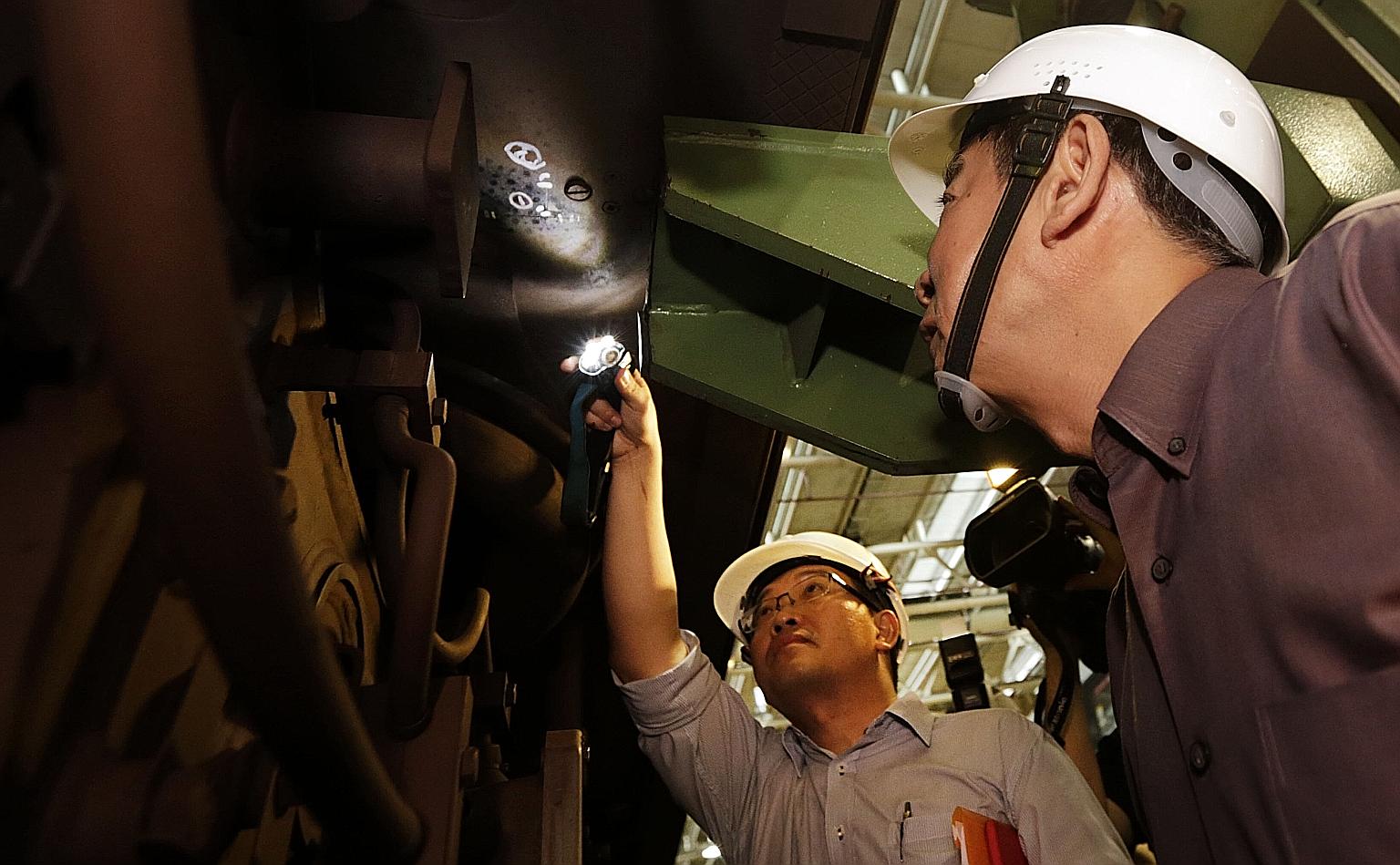Cracks on MRT trains: Khaw addresses key issues raised
Sign up now: Get ST's newsletters delivered to your inbox

Mr Khaw (at right in picture) on a site visit to the Bishan Depot on July 12 to view one of the affected trains with hairline cracks on the bolster. He said the Kawasaki-Sifang train incident has not affected the reliability of the system, as no train delays were caused by the bolsters' hairline cracks.
ST PHOTO: KEVIN LIM
Follow topic:
The cracks found on China-made MRT trains came under scrutiny in Parliament yesterday, with eight MPs questioning Transport Minister Khaw Boon Wan on the issue. Here are the key points:
WHY WAS THE ISSUE NOT MADE PUBLIC EARLIER?
Mr Sitoh Yih Pin (Potong Pasir) asked why the Land Transport Authority (LTA) and SMRT did not inform the public about cracks on the bolster - an aluminium alloy structure under the train carriage - after they were discovered in July 2013, or the subsequent decision to ship them back to China for repairs.
Mr Khaw said the LTA did not publicise the hairline cracks for three reasons:
• There was no safety risk to commuters.
• Manufacturer Kawasaki-Sifang took immediate and full responsibility for the defects and said it would pay for all replacement works, including replacing the bolsters with a new set made in Japan and welding them to new car bodies in China.
• The manufacturer accepted LTA's replacement work schedule, which meant that train services and capacity levels are not affected by the incident.
The LTA would have publicised the defects if any of these factors had not been satisfactorily dealt with, said Mr Khaw.
WAS THERE A SAFETY RISK?
Non-Constituency MP Daniel Goh asked if the defects not being "safety-critical" meant they pose zero safety risks for commuters.
Mr Khaw said the trains can take more than three times the maximum stress they may experience during operations, and the cracks have not reduced this safety margin. An independent assessor, TUV Rheinland, confirmed that the trains are entirely safe to operate.
WHAT DID TUV RHEINLAND FIND AND WILL ITS REPORT BE MADE PUBLIC?
Mr Png Eng Huat (Hougang) asked about TUV Rheinland's technical report. Mr Khaw said the consultant found that "an inherent defect" in certain batches of bolsters was the primary cause of the hairline cracks. The report will be published on LTA's website if the firm agrees.
WHY DID KAWASAKI-SIFANG WIN FURTHER CONTRACTS FOR ADDITIONAL TRAINS?
Non-Constituency MP Dennis Tan asked about the consortium clinching subsequent orders for new trains. Mr Khaw said concerns about the defects had been resolved when tenders, which are based on quality and price assessments, were called.
"Kawasaki-Sifang won the subsequent tenders fairly," he said.
WHAT IMPACT HAS THE ISSUE HAD ON THE MRT SYSTEM?
Mr Pritam Singh (Aljunied GRC) and Mr Sitoh asked if the issue has affected operations as well as plans to improve rail reliability and increase capacity.
Mr Khaw said 124 out of 140 trains for the North-South and East-West lines are put on service during peak hours. Only one train is sent back to China at a time, well within the standard 10 per cent buffer of trains for repairs, upgrading and standby. It does not affect the planned capacity expansion on these lines.
The Kawasaki-Sifang train incident has not affected the reliability of the system, as no train delays were caused by the bolsters' hairline cracks, Mr Khaw added.
HOW LONG IS THE WARRANTY PERIOD FOR TRAINS?
Mr Yee Chia Hsing (Chua Chu Kang GRC) asked about the duration of warranty.
Mr Khaw said there is a defects liability of one year, then an extended warranty of four years.
This period is reset after the bolsters and car bodies are replaced, but the reset applies only to those train components.
WHY ARE THE BOLSTERS FROM JAPAN?
Mr Goh asked why the decision was made for bolsters to be supplied from Japan rather than China and if there is a confidence issue with train parts made in China.
Mr Khaw said the manufacturers had decided to use new bolsters from Japan, and his ministry had agreed. He said the first-generation Kawasaki trains are all on Japanese bolsters. "I don't think we need to read anything more than that into this," he said.
There were no cracks in those earlier trains.

